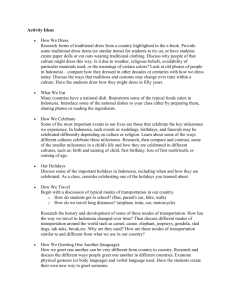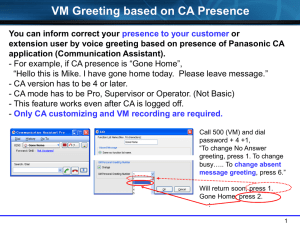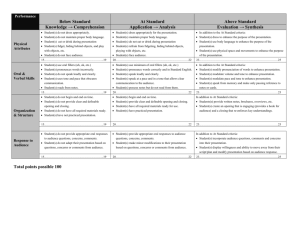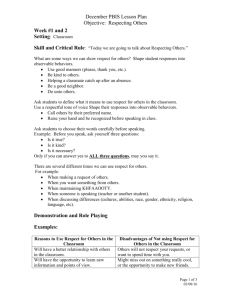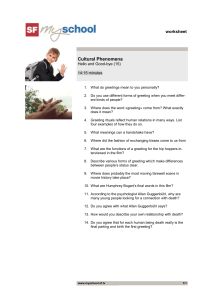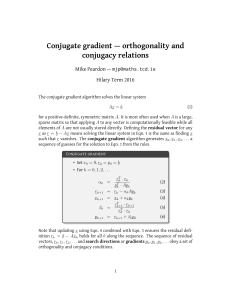Behavior_Management_Staff_Development_Day PAA
advertisement
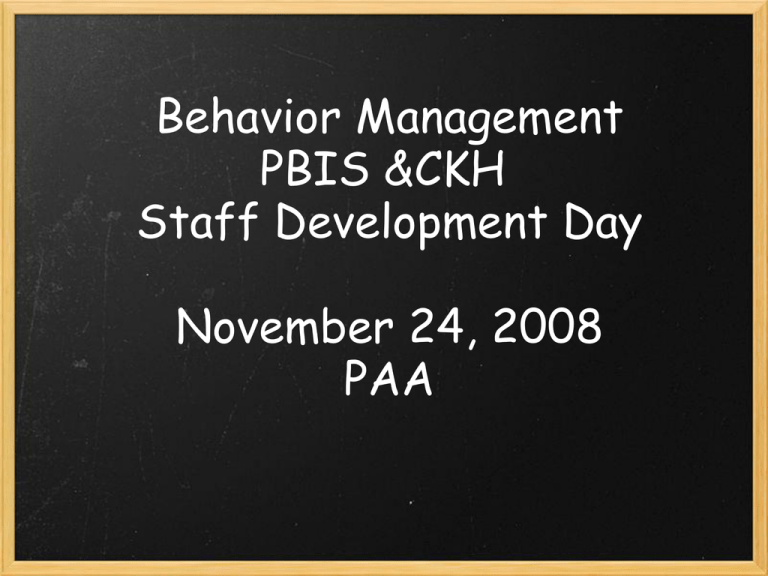
Behavior Management PBIS &CKH Staff Development Day November 24, 2008 PAA WELCOME 9:00 Warm up/Create a Social Contract 9:15 - 9:45 Review of Behavior Matrix Brainstorm needs Building Discussion Groups 9:45 - 10:45 PBIS/CKH Cool Tools, Strategies and Techniques Social Anxiety Theory Social Contract Consequences Four Questions Hand Signals 10:45 11:00 - 11:30 Break Using Cool Tools, Strategies, and Techniques Social Contract Agreement of Our Behavior Please respond to the following questions (by table): 1 How do you want to be treated by leaders? 2. How do you want to be treated by colleagues? 3. How do you think leaders want to be treated? 4. How should people treat each other during times of conflict? Behavior Matrix Review In your building group: 1. Review the building matrix and make notes on any: comments questions concerns 2. Group share and discussion 3. Brainstorm a list of situations that routinely come up in your position which we can help you approach in a practive and supportive manner. Group Share of Concerns to Address Today Concerns MS – voice levels aren’t followed MS – agenda are not in their hands HS – dress code not followed MS – dress code not followed MS – home base activities not be followed HS – time to meet as a team for students – consistency HS – shoving in the halls, throwing things at each other HS – public display of affection in hallways AR- consistency with the matrix DEL – students bring questionable items to school AR – cafeteria and serving lines loud and pushing AR – noise in hallway and classroom very high • AR – students do not respond or listen when spoken to by adult • AR- pushing in the hallway • AR – students in the back of the bus with high display of affection • DE – students do not listen in the hall • MS – have a protocol with ID and show an adult when spoken to • AR- students out of seats on buses while traveling Meet and Greet: Let kids know you care This first step is essential to the success of your time with the students. It begins when you greet students and draw them into a relationship. • Start the day with a positive greeting • Affirm each student • Welcome them as they come in by giving them your full attention • Shake hands or welcome with a greeting Meeting and Greeting Others 58% body language 35% tone of voice 7% what you say • • • • • • • • Smile Be "other" centered Keep eye contact Move with energy Have a positive, welcoming tone of voice Hand shake, high five, etc. Dress and grooming appropriately Take initiative Social Contract • Opportunity to teach the concept of teamwork. An effective social contract = a self managing group. • Part of growing a group means facing conflict in a postive manner for the benifit of supporting teamwork. • The concept of the social contract is most effective when used with all the strategies related to Capturing Kids Hearts . Consequences/ Hand Signals Classroom Hand Signals Pioneer Central School Teacher to Class - to quiet down and pay attention Student to Student - to tell another student to check their behavior Putdowns/Fouls - to tell another student that they putdown another student and need to give 2 put-ups Four Questions The 4 questions should be first used with the whole group to hold them accountaable to self manage thier behavior. 1. What are you doing? 2. What are you supposed to be doing? 3. Are you doing it? 4. What are you going to do about it? • Ask only the given questions • No lecturing during or after • Don't move to the next question until you get an appropriate answer to the question you are asking. • Don't fall for smoke screens/Don't argue • Don't bail them out by giving them the answer. • Don't approach the student when your buttons are pushed. • Watch your body language and tone. • Do not accept "good" or "bad" for an answer. Make the questions work for you. • Initially only ask the question two times • Create silence. • Give genuine affirmations about the person. Teaching Voice Level Why it is important: Explain to class why different voice levels are important and necessary at different times and places throughout school. Five some examples from everyday life: playground, hallway, lunch room, school bus, church, football game, movie theater, cell phones in public places, etc. 0 = Silent 1 = Whisper 2 = Conversation: One – to – one, or small group – can’t be heard on the other side of the room. 3= Presentation: Speaking to a whole room 4= Emergency/Shouting: Outdoors, speaking to a very large group, or maybe gym class only! Role Play of Situations Positive Launch The launch has to do with the way we end and send the students. This is vastly different from just having students rush out the door when the bell rings. This gives you the opportunity to end your time with students on a postive note and paves the way for the next encounter you have with the student.
